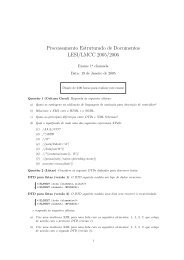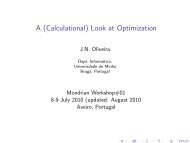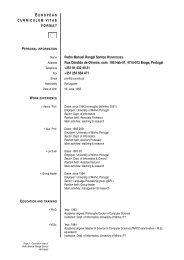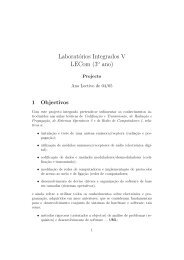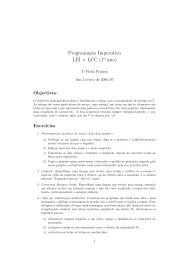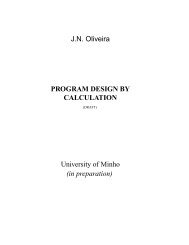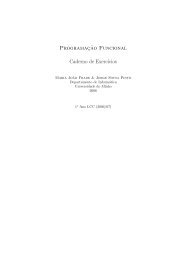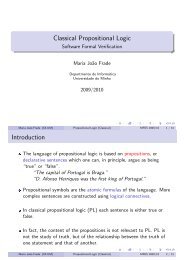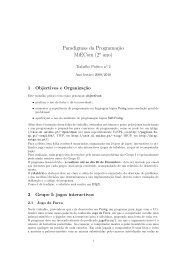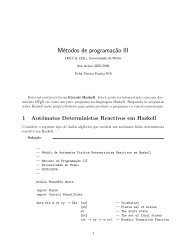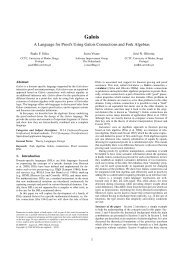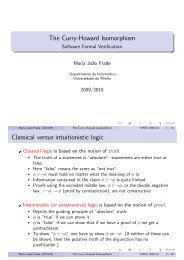Identification of forms and components of VO inheritance
Identification of forms and components of VO inheritance
Identification of forms and components of VO inheritance
- No tags were found...
You also want an ePaper? Increase the reach of your titles
YUMPU automatically turns print PDFs into web optimized ePapers that Google loves.
<strong>Identification</strong> <strong>of</strong> <strong>forms</strong> <strong>and</strong> <strong>components</strong><strong>of</strong> <strong>VO</strong> <strong>inheritance</strong>Iris Karvonen, Iiro Salkari, Martin OllusPro-VE 2007
VTT TECHNICAL RESEARCH CENTRE OF FINLANDECOLEADContent• <strong>VO</strong> <strong>inheritance</strong> concepts at <strong>VO</strong> – network (VBE) interface• Benefits <strong>of</strong> <strong>VO</strong> <strong>inheritance</strong>• <strong>VO</strong> output view - <strong>Identification</strong> <strong>of</strong> <strong>VO</strong> <strong>inheritance</strong> <strong>components</strong>• Network (VBE) view - <strong>VO</strong> <strong>inheritance</strong> <strong>components</strong>• Review <strong>of</strong> main <strong>components</strong>• SME network case studies• ConclusionsECOLEAD:<strong>VO</strong>: Virtual Organization : temporary assignmentVBE: Virtual Organization Breeding Environment (network)12.9.2007Pro-VE 2007 Iris Karvonen2
VTT TECHNICAL RESEARCH CENTRE OF FINLANDECOLEAD<strong>VO</strong> <strong>inheritance</strong> – from temporary projects to continuityChallenge:• Virtual Organizations operate on a temporary basis; timerestrictions• <strong>VO</strong>s incorporate several organizations• After the <strong>VO</strong> people return to their line functions or newprojects-> How to keep the resulting <strong>VO</strong> experience? -> can be storedby the network/VBE-> What are the useful outputs/ elements to be utilized <strong>and</strong>how?<strong>VO</strong>: Virtual Organization : temporary assignmentVBE: Virtual Organization Breeding Environment12.9.2007Pro-VE 2007 Iris Karvonen3
VTT TECHNICAL RESEARCH CENTRE OF FINLANDECOLEAD<strong>VO</strong> – VBE (network) interfaceVBEin <strong>VO</strong> creation: VBEpractices&systems,knowledge,capabilities,resources<strong>VO</strong> operationHeir:• all VBE members• participating <strong>VO</strong> partners• <strong>VO</strong> managementVBEmembersin <strong>VO</strong> operation/evolution: previousexperience data etc.<strong>VO</strong>partnersVBEmanager<strong>VO</strong> dissolution:<strong>inheritance</strong>returned to VBE:<strong>VO</strong>managerproduct/servicepaymentCustomerVBE = Virtual Organization Breeding Environment; <strong>VO</strong>= Virtual Organization12.9.2007Pro-VE 2007 Iris Karvonen5
VTT TECHNICAL RESEARCH CENTRE OF FINLANDECOLEADBenefits <strong>of</strong> <strong>VO</strong> <strong>inheritance</strong>• improving the preparedness <strong>of</strong> the VBE: <strong>VO</strong>s can be created <strong>and</strong>started faster, support for partner selection• increasing the value <strong>of</strong> the VBE for the members, for example byincreasing their knowledge <strong>and</strong> market position• making the <strong>VO</strong>s more effective <strong>and</strong> reliable both in time <strong>and</strong> costs,<strong>and</strong> improving or ensuring the quality,• decreasing <strong>VO</strong> management efforts through increased trust <strong>and</strong>strengthened relationships,• supporting decision-making <strong>and</strong> tracking <strong>of</strong> <strong>VO</strong> problems ordeviations• supporting the marketing <strong>and</strong> sales <strong>of</strong> the VBE services12.9.2007Pro-VE 2007 Iris Karvonen6
VTT TECHNICAL RESEARCH CENTRE OF FINLANDECOLEAD<strong>Identification</strong> <strong>of</strong> <strong>forms</strong> <strong>of</strong> assets– VBE bag <strong>of</strong> assets approach• The VBE Bag <strong>of</strong> Assets refers to all valuable elements thatdifferent VBE Members may wish to share with others <strong>and</strong> whichare available to all VBE members. *• <strong>VO</strong> <strong>inheritance</strong> gives input to VBE Bag <strong>of</strong> Assets• Three types <strong>of</strong> capitals are identified:• Financial capital• Intellectual capital• Social capital* ECOLEAD WP212.9.2007Pro-VE 2007 Iris Karvonen8
VTT TECHNICAL RESEARCH CENTRE OF FINLANDECOLEAD<strong>VO</strong> outputExperience data & information<strong>VO</strong> output - VBE Bag <strong>of</strong> assetsPartner performance dataNew knowledgeSocial relations, trust, motivationMarket position, customer relationsReferencesVBE Bag <strong>of</strong> assetsFinancial capitalIntellectual capitalSocial capital<strong>VO</strong> structures & configurationsObligations, warranties12.9.2007Pro-VE 2007 Iris Karvonen9
VTT TECHNICAL RESEARCH CENTRE OF FINLANDECOLEADClassifications <strong>of</strong> knowledge to be inherited*(intellectual capital)• Entrepreneurial knowledge: markets <strong>and</strong> customers• Technical knowledge: technological viewpoint to the product <strong>and</strong>production.• <strong>VO</strong> management knowledge• Performance measurement model <strong>and</strong> related performance data• Milestones & activities plan• Knowledge concerning <strong>VO</strong> management model• Knowledge related to <strong>VO</strong> structure (= who works with who <strong>and</strong> in which workpackages etc.)• <strong>VO</strong> actions, changes, problems, deviations-> Challenging: Not only quantitative but also qualitative information &knowledge*From project management, applied to <strong>VO</strong>s12.9.2007Pro-VE 2007 Iris Karvonen10
VTT TECHNICAL RESEARCH CENTRE OF FINLANDECOLEADSocial/ relational assets• Between the VBE members:• trust creation both at the personal <strong>and</strong> organizational level• knowing the capabilities, strengths <strong>and</strong> weaknesses• tested groups <strong>of</strong> partners• the creation <strong>of</strong> a VBE “culture”• increase <strong>of</strong> the motivation to work together by succesfull <strong>VO</strong>s• Towards the customers:• improved customer relationship <strong>and</strong> customer’s trust to the VBE• underst<strong>and</strong>ing the customer needs (useful for future business <strong>and</strong>identification <strong>of</strong> new opportunities)• improved personal relationships• knowledge <strong>of</strong> customer practices support the preparedness to work for thecustomer in future• the achieved market position <strong>and</strong> the <strong>VO</strong> references-> Challenging: the social heritage <strong>of</strong> a <strong>VO</strong> may become negative12.9.2007Pro-VE 2007 Iris Karvonen11
VTT TECHNICAL RESEARCH CENTRE OF FINLANDECOLEAD Inheriting financial capital ?• Financial capital is typically owned by the independentorganizations.• Part <strong>of</strong> the pr<strong>of</strong>it created in a <strong>VO</strong> may be inherited to the VBE• How about risks <strong>and</strong> losses (negative financial heritage)?• Warranties <strong>of</strong> the customer product• Other obligations <strong>and</strong> liabilities• Inheritance <strong>of</strong> failed <strong>VO</strong>s, realized risks-> Challenging: Customer’s acceptance; willingness <strong>and</strong> capability <strong>of</strong>the VBE <strong>and</strong> companies to carry risk12.9.2007Pro-VE 2007 Iris Karvonen12
VTT TECHNICAL RESEARCH CENTRE OF FINLANDECOLEADCase studies: SME networks• 8 industrial SME networks were questionnaired about <strong>VO</strong><strong>inheritance</strong>• Current practices• Importance to different parties, importance <strong>of</strong> experience• Requirements & challenges12.9.2007Pro-VE 2007 Iris Karvonen13
VTT TECHNICAL RESEARCH CENTRE OF FINLANDECOLEADPractices <strong>of</strong> SME networks• Mostly no systematic practices but some informal exchange <strong>of</strong>experience between similar <strong>VO</strong>s.• Some examples <strong>of</strong> short term partner performance measurement;for example customer’s requirement.• Network platform / portal exist in most cases but usability low.• Cooperation meetings the most used practice.• Obligations towards the customer carried by the <strong>VO</strong> manager.12.9.2007Pro-VE 2007 Iris Karvonen14
VTT TECHNICAL RESEARCH CENTRE OF FINLANDECOLEADImportance to different partiesImportance <strong>of</strong> <strong>VO</strong>experienceto the <strong>VO</strong>/V Tmanagerto the VBEmembers or <strong>VO</strong>participantsnot /lessimportantimportantveryimportant/necessary- 5 33 5 -to the customer 1 5 212.9.2007Pro-VE 2007 Iris Karvonen15
VTT TECHNICAL RESEARCH CENTRE OF FINLANDECOLEADImportance <strong>of</strong> <strong>VO</strong> experienceOptions <strong>of</strong>feredmost weightingimportantA product knowledge <strong>and</strong> experience 1 243 30B experience <strong>of</strong> the customer relationship, prac ticesetc.C experience about needed tasks, actions,resources, schedules, used approaches,templates etc. (process & managementknowledge)Dexperience about faced changes <strong>and</strong> problems<strong>and</strong> how they were solvedE experience about potentia l partners <strong>and</strong> theirperformance1 29- 24- 23F some other? 2 1312.9.2007Pro-VE 2007 Iris Karvonen16
VTT TECHNICAL RESEARCH CENTRE OF FINLANDECOLEADIn addition to experience –other <strong>inheritance</strong> <strong>components</strong>What does a <strong>VO</strong> give to the participants (except experience <strong>and</strong> theorder&payment)? How does the state <strong>of</strong> the VBE differ before <strong>and</strong> after a<strong>VO</strong>? Reuse <strong>of</strong> <strong>VO</strong> structures? Inheritance <strong>of</strong> obligations?• “The number <strong>and</strong> size <strong>of</strong> <strong>VO</strong>s are the most important performance figures <strong>of</strong> a VBE”• Contribution to new business opportunities, improving customer relationships• State difference <strong>of</strong> a VBE caused by a fulfilled <strong>VO</strong> depends on the developmentstage <strong>of</strong> the VBE• Trust building, motivation <strong>and</strong> commitment; dependent on personal relationships• Missing formalisation <strong>and</strong> company specificity makes it difficult to reuse <strong>VO</strong>structures & infra.• Most <strong>of</strong> the customers <strong>of</strong> the networks do not seem to accept shared responsibility.12.9.2007Pro-VE 2007 Iris Karvonen17
VTT TECHNICAL RESEARCH CENTRE OF FINLANDECOLEADRequirements <strong>of</strong> SME networks for <strong>VO</strong> <strong>inheritance</strong>• Contribution to <strong>VO</strong> <strong>inheritance</strong> should appear rewarding <strong>and</strong> beneficial for theactors.• The information has to be easily accessible for all different users• In some cases the amount <strong>of</strong> data may be a problem for its use, but in most casesthe capture is the main problem.• The contributions required from <strong>VO</strong> participants should be made as easy <strong>and</strong> shortas possible.• Part <strong>of</strong> the needed data could be created automatically or semi-automatically fromthe <strong>VO</strong> monitoring <strong>and</strong> operation. Collection <strong>of</strong> <strong>VO</strong> experience should partly happenas part <strong>of</strong> the <strong>VO</strong> management tasks.• Templates should be created to capture knowledge in order to allow categorization<strong>of</strong> information. On the other h<strong>and</strong>, a sophisticated structure is not as important aseasy search.• The right level <strong>of</strong> openness <strong>and</strong> transparency should be found. In most cases it isunrealistic to have totally “open books”.• All networks are not homogeneous; especially when they are in a growing phase.Part <strong>of</strong> the companies have more experience than the others <strong>and</strong> don’t need all thatinformation which again may be necessary for newcomers <strong>of</strong> the network.12.9.2007Pro-VE 2007 Iris Karvonen18
VTT TECHNICAL RESEARCH CENTRE OF FINLANDECOLEADConclusions• <strong>VO</strong> <strong>inheritance</strong> aims to bridge the gap between the <strong>VO</strong> discontinuity <strong>and</strong>network (VBE) continuity.• <strong>VO</strong> <strong>inheritance</strong> is not only about partner performance measurement.• The network characteristics affect on the rules <strong>of</strong> <strong>inheritance</strong> (openness,responsibilities, avoiding misuse <strong>and</strong> decrease <strong>of</strong> trust).• A challenge is to find <strong>inheritance</strong> mechanisms which don’t require toomany resources.• Social capital / relational assets are an important part <strong>of</strong> <strong>VO</strong> heritage.• The relationships to the customers are more important than therelationships to the VBE members.• The <strong>VO</strong> relational heritage is always not only positive.• Also best practices to preserve the relational <strong>and</strong> structural assets <strong>of</strong> <strong>VO</strong>sshould be found <strong>and</strong> implemented.12.9.2007Pro-VE 2007 Iris Karvonen19
VTT TECHNICAL RESEARCH CENTRE OF FINLANDECOLEADTHANK YOU!12.9.2007Pro-VE 2007 Iris Karvonen20



